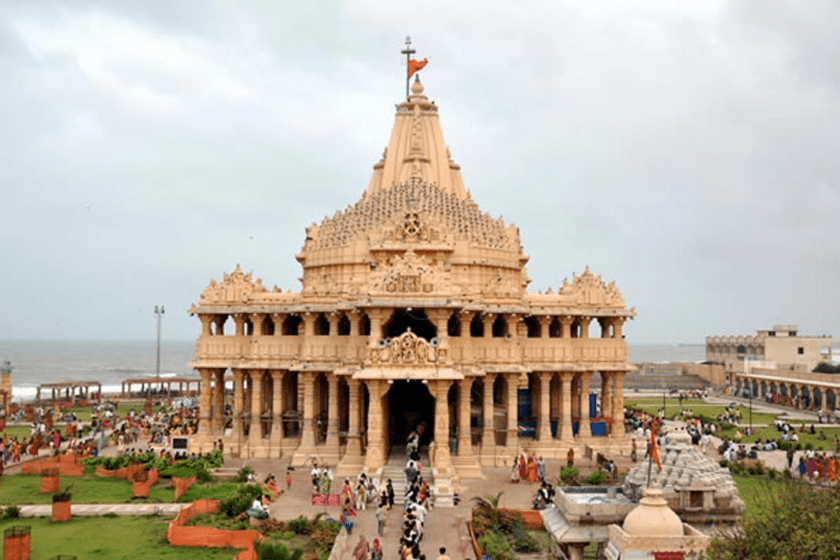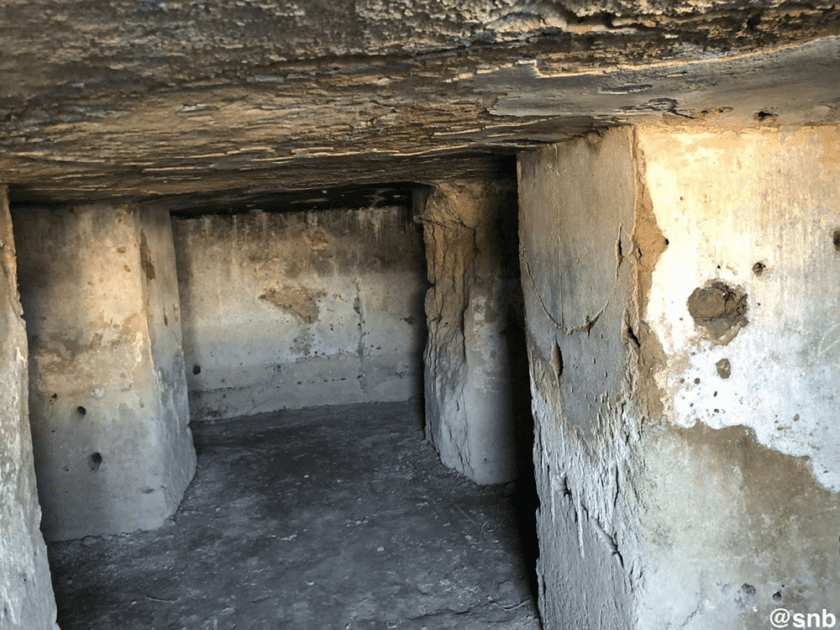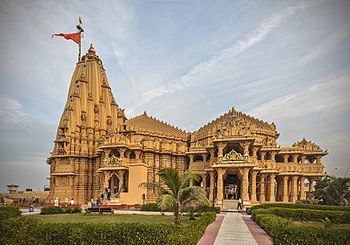Located in Prabhas Patan, Veraval in Gujarat, India, The Somnath temple is the largest and most famous Hindu temple dedicated to Lord Shiva. The temple has a vivid history associated to it. In 1206, during the reign of Bhima 1 , the Turkic Muslim ruler Mahmud of Ghazni raided and destroyed the temple. It was rebuilt by Mahipala 1, but in 1395 it was destroyed again by Zafar Khan.
It was reconstructed and destroyed many times in the past. The present day Somnath temple was constructed under the orders of the then Home Minister, Mr. Vallabhbhai Patel. The temple is a great tourist and religious site. Here are some interesting and unknown facts about The Somnath Temple.
1 – Origin
The 11th-century Persian historian Al-Biruni states that Somnath has become so famous because “it was the harbour for seafaring people, and a station for those who went to and fro between Sufala in the country of Zanj (east Africa) and China. It is unclear when the first version of the Somnath temple was built with estimates varying between the early centuries of the 1st-millennium to about the 9th-century CE.
2. Somnath Temple is one of the twelve Jyotirlingas

Jyotirlingam, is a devotional representation of the Hindu God Shiva. According to Shiva Purana there are 64 original jyotirlinga sites in India, out which 12 are the most sacred and are known as Maha Jyotirlingam, one of which is The Somnath Temple in Gujarat.
3- Legend of the Moon God
The temple was said to be the confluence point of three rivers namely – Kapila, Hiran and Saraswati. The confluence was called Triveni Sangam and is believed to be the place where Soma, the Moon God bathed and regained his luster. The initial structure was first built by Moon God who constructed the temple with Gold. The Sun God constructed it with silver and Lord Krishna used Sandalwood for construction.
4 – Reference in Ancient texts
The legend, as mentioned in the Shiva Purana, says that, once there was an argument between Brahma (the God of creation) and Vishnu (the preserver of creation) and to settle the debate, Shiva pierced the three worlds appearing as a huge infinite pillar of light, the jyotirlinga which later cooled into the holy mountain Annamalai. Both deities started in opposite directions to find the end of the infinite pillar of light. While Vishnu accepted his defeat, Brahma lied about finding the light. This lie enraged Lord Shiva and he cursed Brahma, that he will not be worshipped despite being the creator of the universe. Thus, the Jyotirlinga shrines are temples where Shiva appeared as a fiery column of light.
5 – Repeated destruction
Mahmud of Ghazni raided and looted the temple in 1024 CE, during the reign of Bhima1. He also destroyed the Shiva Lingam in the temple. Mahmud of Ghazni conquered the town and temple after a two-day battle The second destruction of the temple occurred in 1299 by Allauddin Khilji’s army. The idol was later recovered, and the temple was rebuilt by Mahipala I, the king of Saurashtra. In 1395, the governor of Gujarat, Zafar Khan, destroyed it for the third time. In 1451, Mahmud Begada, who was the Sultan of Gujarat at that time, desecrated it. He built a mosque at the site. In 1665, Aurangzeb ordered to destroy it but did not destroy it completely. In 1702, he prohibited Hindus to worship there, otherwise threatening to demolish the temple completely.
6- The Shivalinga
The Shivalinga of this place of worship is supposed to have been securely hiding inside its hollowness. It is supposed that this paranormal stone was able of making the gold. Also, it is supposed that this stone had an alchemic as well as radioactive properties as well as it could make a captivating ground around the stone which assisted it remain balancing above the ground.
7-Position of the place of worship
In the Sanskrit message, found on the Arrow-Pillar named Baan-Stambh raised on the sea-protection wall at the Somnath Temple is affirmed that the temple situates at a point on the Indian piece of land, which is the primary point on the land in the North Pole to the south-pole on that exact longitude.
8- Temple name changes every time the world is reconstructed
According to the holy text of Skand Puran, the name of Somnath Temple changes every time the world is reconstructed. It is said that when Brahma re constructs the world after the destruction of the world we are currently in the name of the temple would change to Pran Nath temple.
9- Temple Architecture
According to archaeological excavations, the temple opened to the east. However, the new design is as such- The temple is built in Chalukya style of temple architecture and is made of sandstones. Shri Prabhashankarbhai Oghadbhai Sompura was the chief architect. The shikhara of the temple is 15 m high and has an 8.2 m long tall flagpole at the top. The kalasha that tops the shikhara weighs 10 tons. The temple is seven-storied and 155 feet tall.
10- The outer architecture

The architecture of the Somnath temple is similar to that of the Chalukyas. The sounds of the sea waves breaking against the coasts may be heard from inside this seaside temple. The temple’s outward attractiveness is accentuated with a tall spire and flagpole. From afar, you can see the dark Saffron flag blowing in the sea air.
11- Somnath Temple was a treasure
Literature and epigraphical evidence suggests that the medieval era Veraval-Patan area port was also actively trading with the Middle East and Southeast Asia. This brought wealth and fame to the Veraval area as well as the temple
12- Proclamation of the Gates by the British
During the First Anglo- Afghan war, in 1842, the Governor-General of India Lord Ellenborough ordered his troops to bring the wooden gates from the tomb of Mahmud of Ghazni in Ghazni, Afghanistan back to India; it was believed Mahmud had taken them from Somnath Temple. However, there was nor there is any evidence that Somnath temple or its site ever had any wooden gates. Nor is there any evidence that Mahmud or later conquerors ever took any gates from Prabhas-Patan region as a part of the plunder. This order has been called The Proclamation of Gates.
13 – Reference in Persian Literature
The destruction of the Somnath temple – called Sūmanāt in Persian literature, and the killing of the infidels has been portrayed as a celebrated event in numerous versions of history, stories and poems found in Persia written over the centuries. The Persian literature has made mythical ahistorical connections of Somnath to Manat – the pre-Islamic Arab goddess, for example. The destruction of both has been celebrated by the Islamic scholars and elites.
14 – Important pilgrimage site
Its history raises questions of tolerance and is a symbol of fanaticism and foreign oppression. Mahmud and Aurangzeb along with the ideology that inspired them are remembered as enemies of the ancient Hindu nation. They are asserted as two historical facts, the former as the first and the latter as the last systematic destroyers of Somnath temple. The reconstructed Somnath temple has been the preferred pilgrimage site for Hindus in Gujarat, often combined with a pilgrimage to Dwarka. The site attracts Hindus from all over India.
15 – Somnath’s Shivalinga
The current Shiva lingam in the Somnath Temple is 4 feet high. Per some legends, the original Shiva lingam at the temple used to levitate in the air. It is believed that the Shiva lingam was hidden within the hollowness of the Syamantaka Mani. Lord Krishna was accused of stealing this miraculous jewel that attracts wealth. The stone is also believed to have magnetic properties, which enabled the Shiva lingam to remain suspended in the air.
16 – Baan Stambha
There is a pillar in the courtyard of that temple which is known as Baan Pillar. There is an arrow made at the top of the pillar and this arrow pillar is a direction guiding pillar whose mouth points towards the Arabian sea. There is one verse (stanza) also written in Sanskrit on the lower part of the pillar which means that there is not a single obstacle in the straight line from this point of the sea to the south pole. It means if you draw a straight line from this point till the south pole, there will be no glacier, island, mountain, etc in the way.
17 – The legend of the name – Somnath
The temple that we now worship was built in 1951, and it was the temple’s seventh construction. According to the Hindu Scripture “Rigveda”, this temple was built by Chandra Dev. That’s why it is known as Somnath Temple.
18 – Hidden caves in Somnath

Many organizations have researched the temple. When they started searching under the temple courtyard, they found a network of many caves there. And according to those archaeologists, there is a building under the temple from where the entrance of the cave is.
19 – Role Of Ahilyadevi Holkar
The Maratha expansion in northern India revived many dilapidated temples. The Ahilyadevi Holkar of Indore built a temple at Somnath. However, the site shows how the temple had been changed into a Muslim structure with arch, these sections Q1exterior and inverted Hindu images. Such modifications in the dilapidated Somnath temple to make it into a Mohammedan sanctuary.
20- Arabian sea – the protector of Somnath Temple
There must have been all the storms, cyclones, and floods in the Arabian Sea. But it is said that this ocean never took its limits and never did any damage to the temple. Rather in the west of India, this sea is the protector of the Somnath temple.
FREQUENTLY ASKED QUESTIONS
Q1. Where is Somnath Temple located?
Ans. The temple is located near Junagadh in Saurashtra. It is located on the West coast of Gujarat.
Q2. What are the different festivals celebrated here?
Ans. Mahashivratri, Golokdham, are the main festivals celebrated here.

